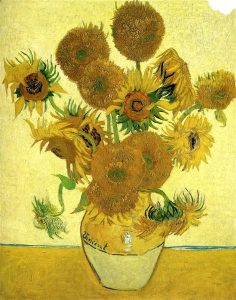Vincent Van Gogh was a Dutch painter. He was part of the Post-Impressionism art movement. After his death, many artists were influenced by his works, although during his life he never reached the popularity he deserved.

Image source: https://search.creativecommons.org/photos/ec5f5215-1307-457f-bc14-3e17d4fa4735 by Christopher S. Penn
Life and education
Vincent Willem Van Gogh was born in the Brabant province of the southern Netherlands in 1853. He came from a protestant family and was the eldest of six children.
At the age of sixteen, he started his apprentice at The Hague as an art dealer. Vincent Van Gogh worked there from 1873 to 1876, first in London and then in Paris. During that period, he formed his artistic sensibility thanks to his employment. He developed a taste for Dutch and French painters like Rembrandt and Millet. He also worked as a language teacher and bookseller. He studied theology to enter the ministry but abandoned his project after a short time. Between 1879 and 1880 he experienced his first spiritual crisis. At that time, he was penniless and everyone around him began to think he was mad. In 1880 he discovered his true vocation as an artist and started drawing and painting seriously.
His career as a painter was brief, in fact, lasted only a decade from 1880 to 1890. At first, he studied drawing techniques at Brussels Academy but then he continued his training as a self-taught. In 1886 he moved to Paris and met other artists, like Pisarro, Monet, and Gaugin that showed him the newest painting techniques of that time. In 1888, he moved to Arles to found his art school. Near the end of that same year, his psychic state got worse until the famous episode in which he cut off part of his ear. Van Gogh then began to alternate moments of lucidity with moments of madness more often and was sent to the asylum in Saint-Remy. In 1890 he died in Auvers-Sur-Oise shooting himself with a gun.

Vincent van Gogh
Developping his style
Van Gogh began drawing and painting at a very young age. He used mainly watercolors, but there are only a few examples of his early works.
In early 1882, his uncle, Cornelis Marinus commissioned him some drawings of The Hague. His uncle wasn’t satisfied with his work so Van Gogh persevered. The result was that he worked for more than a year on single figures experimenting with lighting and different drawing materials. He did highly elaborate studies in black and white that later would be recognized as early masterpieces.
When he moved to Paris, he started painting “en plain air” and began to use oil painting. His subject were life, landscapes, figures referring to the daily life of peasants and the countryside. Van Gogh developed his style thanks to Ruben that showed him his technique of direct notation and the use of the color combination to express a feeling or mood. During his stay in Paris, the painter discovered Japanese prints and Impressionist paintings that influenced him to try a lighter palette in his works. Between 1886 and 1888, his personal distinctive style came to life. His palette became colorful and his subjects less traditional. By the middle of 1887, he was painting in pure colors and using broken brushwork and by the early month of 1888, Van Gogh’s Post-Impressionist style was completely formed.

Image source: https://search.creativecommons.org/photos/342a527d-90d0-448b-b12b-82c9e3407585.by normanrusin
From Post-Impressionism to his last days
During this period, his main subjects were blossoming fruit trees, views of the town and surroundings, landscapes, self-portraits, portraits of his friends, interiors, and exteriors of the house and sunflowers. He struggled to express his feelings about the subject which can be seen in the emphatic contours heightened effects of color. When he moved to Arles, he continued to improve his personal style, but he adjusted his color palette to reflect his surroundings. Van Gogh’s style was spontaneous and instinctive. He worked with great speed and intensity, determined to capture an effect or a mood while it possessed him. The asylum phase (1889–90) was characterized by his fear of losing touch with reality and sadness. He couldn’t choose his subjects while he was confined to his cell or the asylum garden. He realized that his inspiration came from direct observation. There, he muted his vivid colors for a calmer choice of colors in his paintings. He developed a more dramatic style with more attention to the dynamism of forms. When he was released from the asylum, he moved to Auvers-Sur-Oise, in the North of France, his style changed again. He adopted cooler tonalities; his subjects became less contorted; his brushwork became wider and more expressive and his interpretation more lyrical.

Image source: https://www.wikiart.org/en/vincent-van-gogh/landscape-under-a-stormy-sky-1888
Legacy
Today, Vincent Van Gogh is considered one of the greatest painters of all time. His artistic style had a considerable impact on other painters that followed him. His works influenced the development of Fauvism, Expressionism, and Modernism schools of the 20th century. The painter did not live to see his talent recognized. He had a great influence on modern art and inspiration for his contemporary colleagues and generations of artists that followed. His works deeply revolutionized painting styles and artistic methods.

Image source: https://www.wikiart.org/en/vincent-van-gogh/still-life-vase-with-fifteen-sunflowers-1888-1
Info Sources:
https://en.wikipedia.org/wiki/Vincent_van_Gogh
https://www.vangoghgallery.com/misc/biography.html
https://www.britannica.com/biography/Vincent-van-Gogh
https://www.vincentvangogh.org/
